
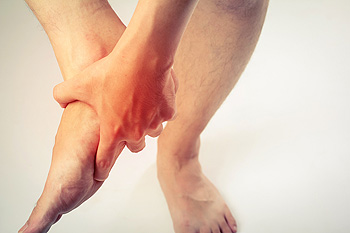 A plantar fibroma is a noncancerous or benign growth in the arch of the foot that slowly grows over time. It develops on the plantar fascia, the ligament that runs along the bottom of the foot and connects the heel to the toes. A fibroma appears as a small bump typically less than an inch in size, and can occur in one or both feet. Often, a plantar fibroma does not cause symptoms. However, a fibroma can cause pain and discomfort if it grows in size, and it may be especially painful if pressure is applied to the area. Some experts say genetics play a factor, but it is not clear what exactly causes plantar fibroma or why, there’s no known way to prevent its occurrence. If you suspect that you have a plantar fibroma, it is suggested that you seek the care of a podiatrist.
A plantar fibroma is a noncancerous or benign growth in the arch of the foot that slowly grows over time. It develops on the plantar fascia, the ligament that runs along the bottom of the foot and connects the heel to the toes. A fibroma appears as a small bump typically less than an inch in size, and can occur in one or both feet. Often, a plantar fibroma does not cause symptoms. However, a fibroma can cause pain and discomfort if it grows in size, and it may be especially painful if pressure is applied to the area. Some experts say genetics play a factor, but it is not clear what exactly causes plantar fibroma or why, there’s no known way to prevent its occurrence. If you suspect that you have a plantar fibroma, it is suggested that you seek the care of a podiatrist.
Foot Pain
Foot pain can be extremely painful and debilitating. If you have a foot pain, consult with one of our podiatrists from Achilles Foot Clinic. Our doctors will assess your condition and provide you with quality foot and ankle treatment.
Causes
Foot pain is a very broad condition that could be caused by one or more ailments. The most common include:
Diagnosis
To figure out the cause of foot pain, podiatrists utilize several different methods. This can range from simple visual inspections and sensation tests to X-rays and MRI scans. Prior medical history, family medical history, and any recent physical traumatic events will all be taken into consideration for a proper diagnosis.
Treatment
Treatment depends upon the cause of the foot pain. Whether it is resting, staying off the foot, or having surgery; podiatrists have a number of treatment options available for foot pain.
If you have any questions, please feel free to contact one our office, located in the South of Calgary, Alberta. We offer the newest diagnostic and treatment technologies for all your foot care needs.
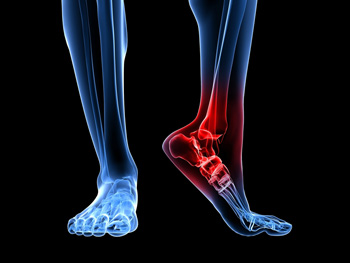 Irritation of the growth plate on the heel can occur in young and teenaged children from participating in running and jumping activities. This is a condition that is referred to as Sever’s disease, and it can cause severe pain and discomfort. Childhood and adolescence is a time of life when the bones in the leg can grow faster than the muscles and tendons, possibly causing heel conditions. Some of the symptoms that can be associated with Sever’s disease include heel pain after arising in the morning and difficulty walking and running. It is suggested that your child stop the activity that may have caused this condition, and mild relief may be found when specific stretches are performed. If you notice that your child is limping or complaining of heel pain, it is strongly suggested that you schedule a consultation with a podiatrist who can properly diagnose and treat Sever’s disease.
Irritation of the growth plate on the heel can occur in young and teenaged children from participating in running and jumping activities. This is a condition that is referred to as Sever’s disease, and it can cause severe pain and discomfort. Childhood and adolescence is a time of life when the bones in the leg can grow faster than the muscles and tendons, possibly causing heel conditions. Some of the symptoms that can be associated with Sever’s disease include heel pain after arising in the morning and difficulty walking and running. It is suggested that your child stop the activity that may have caused this condition, and mild relief may be found when specific stretches are performed. If you notice that your child is limping or complaining of heel pain, it is strongly suggested that you schedule a consultation with a podiatrist who can properly diagnose and treat Sever’s disease.
Sever's disease often occurs in children and teens. If your child is experiencing foot or ankle pain, see one of our podiatrists from Achilles Foot Clinic. Our doctors can treat your child’s foot and ankle needs.
Sever’s Disease
Sever’s disease is also known as calcaneal apophysitis, which is a medical condition that causes heel pain I none or both feet. The disease is known to affect children between the ages of 8 and 14.
Sever’s disease occurs when part of the child’s heel known as the growth plate (calcaneal epiphysis) is attached to the Achilles tendon. This area can suffer injury when the muscles and tendons of the growing foot do not keep pace with bone growth. Therefore, the constant pain which one experiences at the back of the heel will make the child unable to put any weight on the heel. The child is then forced to walk on their toes.
Symptoms
Acute pain – Pain associated with Sever’s disease is usually felt in the heel when the child engages in physical activity such as walking, jumping and or running.
Highly active – Children who are very active are among the most susceptible in experiencing Sever’s disease, because of the stress and tension placed on their feet.
If you have any questions, please feel free to contact one our office, located in the South of Calgary, Alberta. We offer the newest diagnostic and treatment technologies for all your foot care needs.
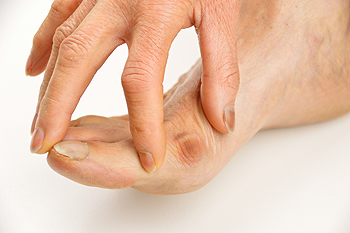 There are several reasons why bunions may develop. These can include genetic factors, wearing shoes that do not fit correctly, a foot deformity, or from a medical condition like arthritis. A bunion is defined as a bone that protrudes from the joint in the big toe, and may cause severe pain and discomfort. Additional symptoms of a bunion can consist of swelling and redness surrounding the affected joint, and the toe may be difficult to move. After a proper diagnosis is made, which generally involves having an X-ray taken and a physical examination of the foot is performed, proper treatment can begin. Orthotics may be prescribed and it is beneficial to wear shoes that have low heels and a wide toe box. If your bunion is very painful or causing difficulty walking, it is strongly suggested that you are examined by a podiatrist.
There are several reasons why bunions may develop. These can include genetic factors, wearing shoes that do not fit correctly, a foot deformity, or from a medical condition like arthritis. A bunion is defined as a bone that protrudes from the joint in the big toe, and may cause severe pain and discomfort. Additional symptoms of a bunion can consist of swelling and redness surrounding the affected joint, and the toe may be difficult to move. After a proper diagnosis is made, which generally involves having an X-ray taken and a physical examination of the foot is performed, proper treatment can begin. Orthotics may be prescribed and it is beneficial to wear shoes that have low heels and a wide toe box. If your bunion is very painful or causing difficulty walking, it is strongly suggested that you are examined by a podiatrist.
If you are suffering from bunions, contact one of our podiatrists of Achilles Foot Clinic. Our doctors can provide the care you need to keep you pain-free and on your feet.
What Is a Bunion?
A bunion is formed of swollen tissue or an enlargement of boney growth, usually located at the base joint of the toe that connects to the foot. The swelling occurs due to the bones in the big toe shifting inward, which impacts the other toes of the foot. This causes the area around the base of the big toe to become inflamed and painful.
Why Do Bunions Form?
Genetics – Susceptibility to bunions are often hereditary
Stress on the feet – Poorly fitted and uncomfortable footwear that places stress on feet, such as heels, can worsen existing bunions
How Are Bunions Diagnosed?
Doctors often perform two tests – blood tests and x-rays – when trying to diagnose bunions, especially in the early stages of development. Blood tests help determine if the foot pain is being caused by something else, such as arthritis, while x-rays provide a clear picture of your bone structure to your doctor.
How Are Bunions Treated?
If you have any questions, please feel free to contact one our office, located in the South of Calgary, Alberta. We offer the newest diagnostic and treatment technologies for all your foot care needs.
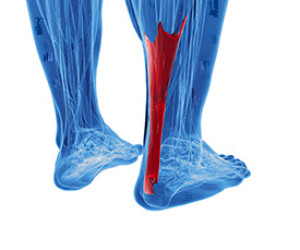 Patients who have experienced an Achilles tendon injury are often aware of the severe pain and discomfort this can cause. It can occur from repetitive irritation, or from a sudden injury. Additionally, wearing shoes that do not fit correctly, or having an abnormal foot structure may contribute to the onset of this type of injury. The symptoms that are often associated with this condition can consist of extreme tenderness in the heel, calf, and ankle, and it can be difficult to walk. It is beneficial to consult with a podiatrist if you have endured an Achilles tendon injury. A podiatrist can guide you toward the right treatments for you.
Patients who have experienced an Achilles tendon injury are often aware of the severe pain and discomfort this can cause. It can occur from repetitive irritation, or from a sudden injury. Additionally, wearing shoes that do not fit correctly, or having an abnormal foot structure may contribute to the onset of this type of injury. The symptoms that are often associated with this condition can consist of extreme tenderness in the heel, calf, and ankle, and it can be difficult to walk. It is beneficial to consult with a podiatrist if you have endured an Achilles tendon injury. A podiatrist can guide you toward the right treatments for you.
Achilles tendon injuries need immediate attention to avoid future complications. If you have any concerns, contact one of our podiatrists of Achilles Foot Clinic. Our doctors can provide the care you need to keep you pain-free and on your feet.
What Is the Achilles Tendon?
The Achilles tendon is a tendon that connects the lower leg muscles and calf to the heel of the foot. It is the strongest tendon in the human body and is essential for making movement possible. Because this tendon is such an integral part of the body, any injuries to it can create immense difficulties and should immediately be presented to a doctor.
What Are the Symptoms of an Achilles Tendon Injury?
There are various types of injuries that can affect the Achilles tendon. The two most common injuries are Achilles tendinitis and ruptures of the tendon.
Achilles Tendinitis Symptoms
Rupture Symptoms
Treatment and Prevention
Achilles tendon injuries are diagnosed by a thorough physical evaluation, which can include an MRI. Treatment involves rest, physical therapy, and in some cases, surgery. However, various preventative measures can be taken to avoid these injuries, such as:
If you have any questions, please feel free to contact one our office, located in the South of Calgary, Alberta. We offer the newest diagnostic and treatment technologies for all your foot care needs.
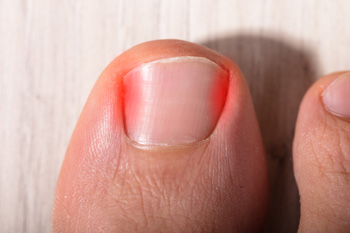 The condition that is referred to as ingrown toenails is quite a common ailment. It occurs as a result of the outer edges of the toenail growing into the surrounding skin. The big toe is often affected when this condition develops, and it may happen for several reasons. These can consist of genetic factors, certain medical conditions, and wearing shoes that do not have adequate room for the toes to move freely in. Patients who are diabetic or who have poor circulation, may be prone to developing ingrown toenails. Some of the symptoms that are associated with ingrown toenails can include tenderness around the affected toe, swelling, and in severe cases, a discharge may be evident. Possible prevention techniques can include trimming the toenails correctly, and wearing shoes and socks that fit properly. If you are afflicted with an ingrown toenail or seem to have reoccurring ingrown toenails, it is suggested that you consult with a podiatrist who can effectively treat this condition.
The condition that is referred to as ingrown toenails is quite a common ailment. It occurs as a result of the outer edges of the toenail growing into the surrounding skin. The big toe is often affected when this condition develops, and it may happen for several reasons. These can consist of genetic factors, certain medical conditions, and wearing shoes that do not have adequate room for the toes to move freely in. Patients who are diabetic or who have poor circulation, may be prone to developing ingrown toenails. Some of the symptoms that are associated with ingrown toenails can include tenderness around the affected toe, swelling, and in severe cases, a discharge may be evident. Possible prevention techniques can include trimming the toenails correctly, and wearing shoes and socks that fit properly. If you are afflicted with an ingrown toenail or seem to have reoccurring ingrown toenails, it is suggested that you consult with a podiatrist who can effectively treat this condition.
Ingrown toenails may initially present themselves as a minor discomfort, but they may progress into an infection in the skin without proper treatment. For more information about ingrown toenails, contact one of our podiatrists of Achilles Foot Clinic. Our doctors can provide the care you need to keep you pain-free and on your feet.
Ingrown Toenails
Ingrown toenails are caused when the corner or side of a toenail grows into the soft flesh surrounding it. They often result in redness, swelling, pain, and in some cases, infection. This condition typically affects the big toe and may recur if it is not treated properly.
Causes
You are more likely to develop an ingrown toenail if you are obese, have diabetes, arthritis, or have any fungal infection in your nails. Additionally, people who have foot or toe deformities are at a higher risk of developing an ingrown toenail.
Symptoms
Some symptoms of ingrown toenails are redness, swelling, and pain. In rare cases, there may be a yellowish drainage coming from the nail.
Treatment
Ignoring an ingrown toenail can have serious complications. Infections of the nail border can progress to a deeper soft-tissue infection, which can then turn into a bone infection. You should always speak with your podiatrist if you suspect you have an ingrown toenail, especially if you have diabetes or poor circulation.
If you have any questions, please feel free to contact one our office, located in the South of Calgary, Alberta. We offer the newest diagnostic and treatment technologies for all your foot care needs.